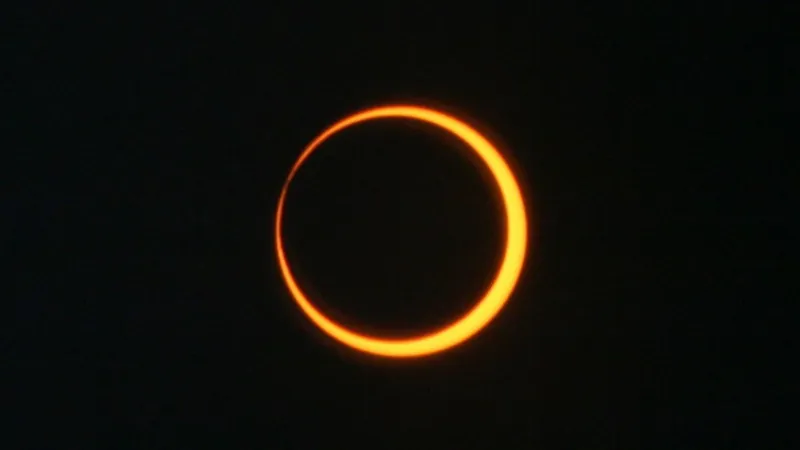
What Time Can You Witness the Breathtaking Annular Solar Eclipse on Oct. 2?
2024-09-30
Author: Jacques
When to Catch the "Ring of Fire"
The timings of this celestial event will vary based on where you are located. For those eager to experience the eclipse, here's the schedule:
- The **partial eclipse** will kick off at **11:43 a.m. EDT (15:43 GMT)**.
- The **annular phase**, where the ring of fire first appears, will start at **12:50 p.m. EDT (16:50 GMT)**.
- The **maximum eclipse** will occur at **2:45 p.m. EDT (18:45 GMT)**.
However, if you're looking for the optimal time to watch the most stunning part of the eclipse live, tune in between **3:03 and 3:09 p.m. EDT (19:03 to 19:09 GMT)**, especially if you're in the vicinity of Easter Island/Rapa Nui. Observers here will get treated to the "ring of fire" for an incredible duration of up to **6 minutes and 11 seconds**!
A Global Perspectives on the Eclipse
The subsequent opportunity to witness this extraordinary spectacle will be between **4:18 and 4:31 p.m. EDT (20:18 to 20:31 GMT)**, when the ring of fire can be seen from southern Chile and Argentina.
Eager to keep track of the latest updates? Various organizations, including Space.com, will feature live blogs and streaming coverage leading up to and during the event. Make sure to stay tuned for links to these streams as they become available!
What Causes This Celestial Wonder?
Understanding the mechanics behind solar eclipses can deepen your appreciation for these awe-inspiring events. The type of solar eclipse—whether total or annular—depends on the nuanced interplay of the Earth and the moon's distances. The moon's orbit is not a perfect circle but rather slightly elliptical, which influences its size in the sky as seen from Earth.
In the case of the October 2 eclipse, the moon will be just far enough away that it cannot fully obscure the sun, thus creating the visually stunning ring effect. The moon’s shadow will trace a path across the globe, measuring approximately **165 miles wide (266 kilometers)**, crossing parts of the Pacific Ocean and reaching southern regions of Chile and Argentina.
Safety First!
As always with solar eclipses, remember that viewing the sun directly without proper protection can lead to severe eye damage. Always use specially designed solar eclipse glasses to ensure your viewing experience is both captivating and safe.
Don’t miss this once-in-a-lifetime opportunity to witness the beauty of the cosmos! The ring of fire awaits, and it’s going to be spectacular!









 Brasil (PT)
Brasil (PT)
 Canada (EN)
Canada (EN)
 Chile (ES)
Chile (ES)
 España (ES)
España (ES)
 France (FR)
France (FR)
 Hong Kong (EN)
Hong Kong (EN)
 Italia (IT)
Italia (IT)
 日本 (JA)
日本 (JA)
 Magyarország (HU)
Magyarország (HU)
 Norge (NO)
Norge (NO)
 Polska (PL)
Polska (PL)
 Schweiz (DE)
Schweiz (DE)
 Singapore (EN)
Singapore (EN)
 Sverige (SV)
Sverige (SV)
 Suomi (FI)
Suomi (FI)
 Türkiye (TR)
Türkiye (TR)